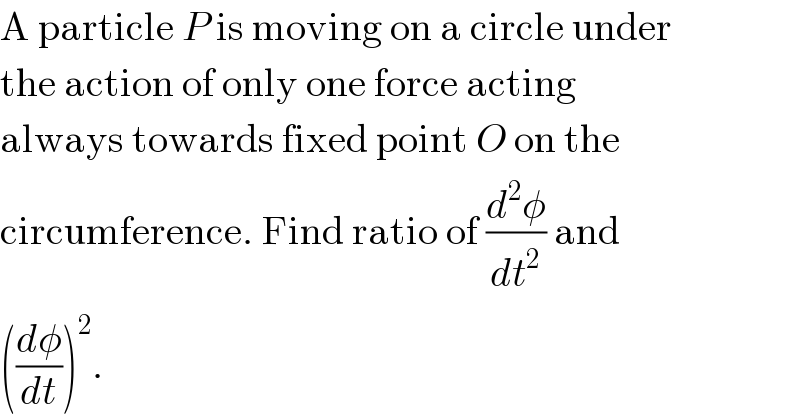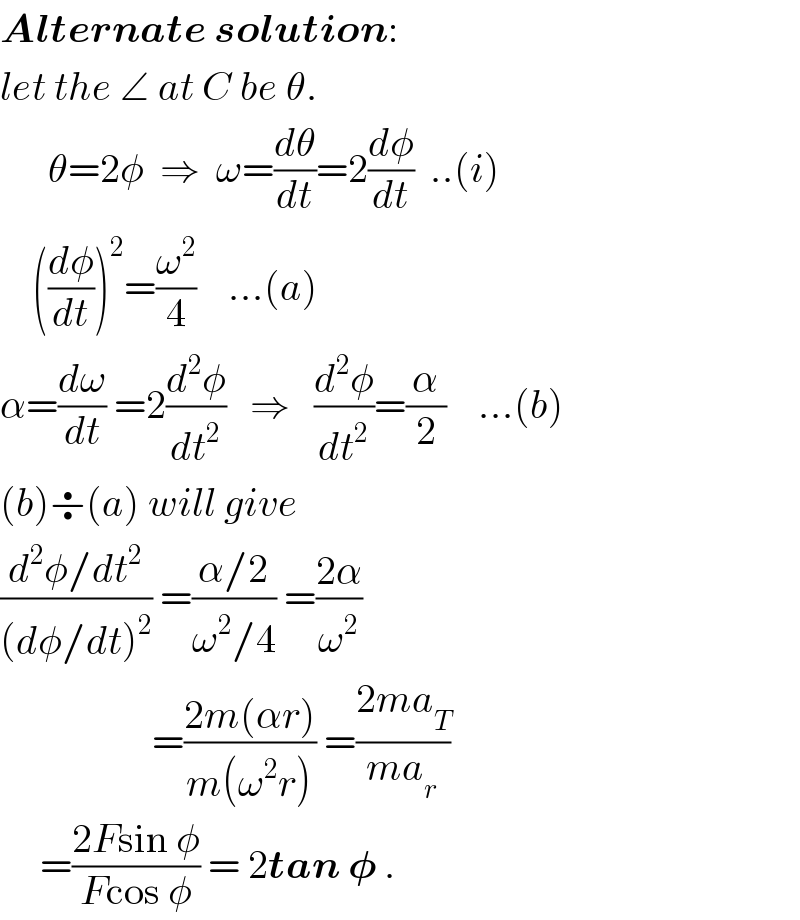
Question Number 22145 by Tinkutara last updated on 11/Oct/17

$$\mathrm{A}\:\mathrm{particle}\:{P}\:\mathrm{is}\:\mathrm{moving}\:\mathrm{on}\:\mathrm{a}\:\mathrm{circle}\:\mathrm{under} \\ $$$$\mathrm{the}\:\mathrm{action}\:\mathrm{of}\:\mathrm{only}\:\mathrm{one}\:\mathrm{force}\:\mathrm{acting} \\ $$$$\mathrm{always}\:\mathrm{towards}\:\mathrm{fixed}\:\mathrm{point}\:{O}\:\mathrm{on}\:\mathrm{the} \\ $$$$\mathrm{circumference}.\:\mathrm{Find}\:\mathrm{ratio}\:\mathrm{of}\:\frac{{d}^{\mathrm{2}} \phi}{{dt}^{\mathrm{2}} }\:\mathrm{and} \\ $$$$\left(\frac{{d}\phi}{{dt}}\right)^{\mathrm{2}} . \\ $$
Commented by Tinkutara last updated on 11/Oct/17

Commented by sma3l2996 last updated on 12/Oct/17
![we have F^→ =ma^→ ⇔a^→ =−(F/m)u^→ ...(i) and OP^(→) =2Rcos(φ)u^→ so v^→ (P)=((dOP^(→) )/dt)=2R[−φ^. sin(φ)u^→ +φ^. cos(φ)k^→ ]=2Rφ^. (−sinφu^→ +cosφk^→ ) and a^→ (P)=(dv^→ /dt)=2R[φ^(..) (−sinφu^→ +cosφk^→ )+φ^. (−φ^. cosφu^→ −φ^. sinφk^→ −φ^. sinφk^→ −φ^. cosφu^→ )] so : a^→ =2R[(−φ^(..) sinφ−2φ^. ^2 cosφ)u^→ +(φ^(..) cosφ−2φ^. ^2 sinφ)k^→ ] ...(ii) we have (i)=(ii) so 2R(−φ^(..) sinφ−2φ^. ^2 cosφ)=((−F)/m) and φ^(..) cosφ−2φ^. ^2 sinφ=0 so φ^(..) cosφ=2φ^. ^2 sinφ ⇔φ^(..) =2φ^. ^2 tan(φ) ...(3i) φ^(..) sinφ+2φ^. ^2 cosφ=(F/(2Rm)) ...(4i) (3i)→(4i)⇒ 2φ^. ^2 tan(φ)sin(φ)+2φ^. ^2 cosφ=(F/(2Rm)) 2φ^. ^2 cosφ(((tan(φ)sinφ)/(cosφ))+1)=(F/(2Rm)) 2φ^. ^2 cosφ(tan^2 φ+1)=(F/(2Rm)) ((dφ/dt))^2 =φ^. ^2 =(F/(4Rm))cosφ and φ^(..) =2φ^. ^2 tanφ=2((F/(4Rm))cosφ)tanφ so : (d^2 φ/dt^2 )=φ^(..) =(F/(2Rm))sinφ](Q22149.png)
$${we}\:{have}\:\:\overset{\rightarrow} {{F}}={m}\overset{\rightarrow} {{a}}\Leftrightarrow\overset{\rightarrow} {{a}}=−\frac{{F}}{{m}}\overset{\rightarrow} {{u}}\:...\left({i}\right) \\ $$$${and}\:\:\overset{\rightarrow} {{OP}}=\mathrm{2}{Rcos}\left(\phi\right)\overset{\rightarrow} {{u}}\:\:\:\: \\ $$$${so}\:\overset{\rightarrow} {{v}}\left({P}\right)=\frac{{d}\overset{\rightarrow} {{OP}}}{{dt}}=\mathrm{2}{R}\left[−\overset{.} {\phi}{sin}\left(\phi\right)\overset{\rightarrow} {{u}}+\overset{.} {\phi}{cos}\left(\phi\right)\overset{\rightarrow} {{k}}\right]=\mathrm{2}{R}\overset{.} {\phi}\left(−{sin}\phi\overset{\rightarrow} {{u}}+{cos}\phi\overset{\rightarrow} {{k}}\right) \\ $$$${and}\:\:\:\overset{\rightarrow} {{a}}\left({P}\right)=\frac{{d}\overset{\rightarrow} {{v}}}{{dt}}=\mathrm{2}{R}\left[\overset{..} {\phi}\left(−{sin}\phi\overset{\rightarrow} {{u}}+{cos}\phi\overset{\rightarrow} {{k}}\right)+\overset{.} {\phi}\left(−\overset{.} {\phi}{cos}\phi\overset{\rightarrow} {{u}}−\overset{.} {\phi}{sin}\phi\overset{\rightarrow} {{k}}−\overset{.} {\phi}{sin}\phi\overset{\rightarrow} {{k}}−\overset{.} {\phi}{cos}\phi\overset{\rightarrow} {{u}}\right)\right] \\ $$$${so}\::\:\overset{\rightarrow} {{a}}=\mathrm{2}{R}\left[\left(−\overset{..} {\phi}{sin}\phi−\mathrm{2}\overset{.} {\phi}\:^{\mathrm{2}} {cos}\phi\right)\overset{\rightarrow} {{u}}+\left(\overset{..} {\phi}{cos}\phi−\mathrm{2}\overset{.} {\phi}\:^{\mathrm{2}} {sin}\phi\right)\overset{\rightarrow} {{k}}\right]\:...\left({ii}\right) \\ $$$${we}\:{have}\:\left({i}\right)=\left({ii}\right) \\ $$$${so}\: \\ $$$$\mathrm{2}{R}\left(−\overset{..} {\phi}{sin}\phi−\mathrm{2}\overset{.} {\phi}\:^{\mathrm{2}} {cos}\phi\right)=\frac{−{F}}{{m}}\:\:{and}\:\:\overset{..} {\phi}{cos}\phi−\mathrm{2}\overset{.} {\phi}\:^{\mathrm{2}} {sin}\phi=\mathrm{0} \\ $$$${so}\: \\ $$$$\overset{..} {\phi}{cos}\phi=\mathrm{2}\overset{.} {\phi}\:^{\mathrm{2}} {sin}\phi\:\Leftrightarrow\overset{..} {\phi}=\mathrm{2}\overset{.} {\phi}\:^{\mathrm{2}} {tan}\left(\phi\right)\:...\left(\mathrm{3}{i}\right) \\ $$$$\overset{..} {\phi}{sin}\phi+\mathrm{2}\overset{.} {\phi}\:^{\mathrm{2}} {cos}\phi=\frac{{F}}{\mathrm{2}{Rm}}\:...\left(\mathrm{4}{i}\right) \\ $$$$\left(\mathrm{3}{i}\right)\rightarrow\left(\mathrm{4}{i}\right)\Rightarrow\:\mathrm{2}\overset{.} {\phi}\:^{\mathrm{2}} {tan}\left(\phi\right){sin}\left(\phi\right)+\mathrm{2}\overset{.} {\phi}\:^{\mathrm{2}} {cos}\phi=\frac{{F}}{\mathrm{2}{Rm}} \\ $$$$\mathrm{2}\overset{.} {\phi}\:^{\mathrm{2}} {cos}\phi\left(\frac{{tan}\left(\phi\right){sin}\phi}{{cos}\phi}+\mathrm{1}\right)=\frac{{F}}{\mathrm{2}{Rm}} \\ $$$$\mathrm{2}\overset{.} {\phi}\:^{\mathrm{2}} {cos}\phi\left({tan}^{\mathrm{2}} \phi+\mathrm{1}\right)=\frac{{F}}{\mathrm{2}{Rm}} \\ $$$$\left(\frac{{d}\phi}{{dt}}\right)^{\mathrm{2}} =\overset{.} {\phi}\:^{\mathrm{2}} =\frac{{F}}{\mathrm{4}{Rm}}{cos}\phi \\ $$$${and}\:\overset{..} {\phi}=\mathrm{2}\overset{.} {\phi}\:^{\mathrm{2}} {tan}\phi=\mathrm{2}\left(\frac{{F}}{\mathrm{4}{Rm}}{cos}\phi\right){tan}\phi \\ $$$${so}\::\:\:\frac{{d}^{\mathrm{2}} \phi}{{dt}^{\mathrm{2}} }=\overset{..} {\phi}=\frac{{F}}{\mathrm{2}{Rm}}{sin}\phi \\ $$
Commented by sma3l2996 last updated on 12/Oct/17

Answered by ajfour last updated on 12/Oct/17

$$\boldsymbol{{Alternate}}\:\boldsymbol{{solution}}: \\ $$$${let}\:{the}\:\angle\:{at}\:{C}\:{be}\:\theta. \\ $$$$\:\:\:\:\:\:\theta=\mathrm{2}\phi\:\:\Rightarrow\:\:\omega=\frac{{d}\theta}{{dt}}=\mathrm{2}\frac{{d}\phi}{{dt}}\:\:..\left({i}\right) \\ $$$$\:\:\:\:\left(\frac{{d}\phi}{{dt}}\right)^{\mathrm{2}} =\frac{\omega^{\mathrm{2}} }{\mathrm{4}}\:\:\:\:...\left({a}\right) \\ $$$$\alpha=\frac{{d}\omega}{{dt}}\:=\mathrm{2}\frac{{d}^{\mathrm{2}} \phi}{{dt}^{\mathrm{2}} }\:\:\:\Rightarrow\:\:\:\frac{{d}^{\mathrm{2}} \phi}{{dt}^{\mathrm{2}} }=\frac{\alpha}{\mathrm{2}}\:\:\:\:...\left({b}\right) \\ $$$$\left({b}\right)\boldsymbol{\div}\left({a}\right)\:{will}\:{give} \\ $$$$\frac{{d}^{\mathrm{2}} \phi/{dt}^{\mathrm{2}} }{\left({d}\phi/{dt}\right)^{\mathrm{2}} }\:=\frac{\alpha/\mathrm{2}}{\omega^{\mathrm{2}} /\mathrm{4}}\:=\frac{\mathrm{2}\alpha}{\omega^{\mathrm{2}} } \\ $$$$\:\:\:\:\:\:\:\:\:\:\:\:\:\:\:\:\:\:\:=\frac{\mathrm{2}{m}\left(\alpha{r}\right)}{{m}\left(\omega^{\mathrm{2}} {r}\right)}\:=\frac{\mathrm{2}{ma}_{{T}} }{{ma}_{{r}} } \\ $$$$\:\:\:\:\:=\frac{\mathrm{2}{F}\mathrm{sin}\:\phi}{{F}\mathrm{cos}\:\phi}\:=\:\mathrm{2}\boldsymbol{{tan}}\:\boldsymbol{\phi}\:. \\ $$
Commented by Tinkutara last updated on 12/Oct/17

$$\mathrm{Thank}\:\mathrm{you}\:\mathrm{very}\:\mathrm{much}\:\mathrm{Sir}! \\ $$
